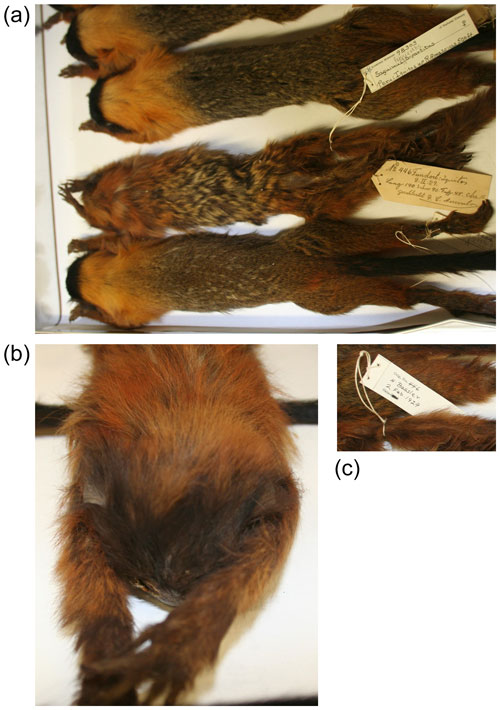Aquino, R., Cornejo, F. M., Cortés Ortiz, L., Encarnación, C. F., Heymann, E. W., Marsh, L. K., Mittermeier, R. A., Rylands, A. B., and Vermeer, J.: Monkeys of Peru, Pocket identification guide, Tropical Pocket Guide Series, Conservation International, Arlington, 2015.
Buckner, J. C., Lynch Alfaro, J. W., Rylands, A. B., and Alfaro, M. E.:
Biogeography of the marmosets and tamarins (Callitrichidae), Mol. Phylogenet. Evol., 82, 413–425, 2015.
da Cruz Lima, E.: Mammals of Amazonia 1, General introduction and Primates, Museo Paraense Emilio Goeldi de Historia Natural e Etnografia, Belém, Rio de Janeiro, 274 pp., 1945.
Dominy, N. J., Ikram, S., Moritz, G. L., Wheatley, P. V., Christensen, J.
N., Chipman, J. W., and Koch, P. L.: Mummified baboons reveal the far reach
of early Egyptian mariners, eLife, 9, e60860, https://doi.org/10.7554/eLife.60860, 2020.
Encarnación, F., Castro, N., and de Rham, P.: Observaciones sobre
primates no humanos en el río Yuvineto (río Putumayo), Loreto,
Perú, in: La Primatología en el Perú. Investigaciones
Primatológicas (1973–1985), edited by: Castro-Rodríguez, N. E.,
Imprenta Propaceb, Lima, 68–79, 1990.
Hershkovitz, P.: Taxonomic notes on tamarins, genus Saguinus
(Callithricidae, Primates) with descriptions of four new forms, Folia
Primatol., 4, 381–395, 1966.
Hershkovitz, P.: Living New World Monkeys (Platyrrhini), Vol. 1, University of Chicago Press, Chicago, ISBN 0226327884, 1977.
Koehler, G., Kardynal, K., and Hobson, K.: Geographical assignment of polar
bears using multi-element isoscapes, Scientific Reports, 9, 9390, https://doi.org/10.1038/s41598-019-45874-w, 2019.
Matauschek, C., Roos, C., and Heymann, E. W.: Mitochondrial phylogeny of tamarins (Saguinus, Hoffmannsegg 1807) with taxonomic and biogeographic implications for the S. nigricollis species group, Am. J. Phys. Anthropol., 144, 564–574, 2011.
Mittermeier, R. A. and Rylands, A. B.: New primates described from 1 January 1990 to 1 September 2021, available at: http://www.primate-sg.org/new_species, last access: 20 December 2021.
Myers, C. W.: A history of herpetology at the American Museum of Natural History, B. Am. Mus. Nat. Hist., 252, 1–232, 2000.
Peres, C. A., Patton, J. L., and da Silva, M. N. F.: Riverine barriers and
gene flow in Amazonian saddle-back tamarins, Folia Primatol., 67,
113–124, 1996.
Rylands, A. B., Matauschek, C., Aquino, R., Encarnación, F., de la Torre, S., Heymann, E. W., and Mittermeier, R. A.: The range of the
golden-mantle tamarin, Saguinus tripartitus (Milne Edwards, 1878): distributions and sympatry of
four tamarin species in Colombia, Ecuador, and northern Peru, Primates, 52,
25–39, 2011.
Rylands, A. B., Heymann, E. W., Lynch Alfaro, J., Buckner, J. C., Roos, C.,
Matauschek, C., Boubli, J. P., Sampaio, R., and Mittermeier, R. A.:
Taxonomic review of the New World tamarins (Primates: Callitrichidae),
Zool. J. Linn. Soc.-Lond., 177, 1003–1028, 2016.
Sampaio, R., Röhe, F., Pinho, G., de Sousa e Silva-Júnior, J., Farias, I., and Rylands, A.: Re-description and assessment of the taxonomic status of Saguinus fuscicollis cruzlimai Hershkovitz, 1966 (Primates, Callitrichinae), Primates, 56, 131–144, 2015.
Thorington, R. W.: Taxonomic status of Saguinus tripartitus (Milne-Edwards, 1878), Am. J. Primatol., 15, 367–371, 1988.
Voss, R. S. and Fleck, D. W.: Mammalian diversity and Matses ethnomammalogy in Amazonian Peru, Part 1, Primates, B. Am. Mus. Nat. Hist., 351, 1–81, 2011.




